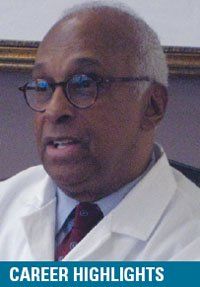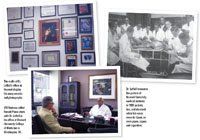LaSalle Leffall: Often the ‘first,’ & never the last
As a boy growing up in the Jim Crow South, LaSalle Leffall, Jr., MD, lifted himself above that era’s stifling segregation by embracing his father’s rock-solid credo: With a good education and hard work, combined with honesty and integrity, there are no boundaries.
ABSTRACT: A broken bird led him to a lifetime in medicine.

As a boy growing up in the Jim Crow South, LaSalle Leffall, Jr., MD, lifted himself above that era’s stifling segregation by embracing his father’s rock-solid credo: With a good education and hard work, combined with honesty and integrity, there are no boundaries.
This fatherly advice became Dr. Leffall’s personal mantra, serving as a bulwark against negativism and setting the framework on which his distinguished medical career was built.
Mending a broken wing
Born in Tallahassee in 1930, Dr. Leffall grew up in Quincy, Florida, where his father was a high school principal. His father had always told him a career in medicine was especially honorable.
“When I was 9 years old, I found a little bird with an injured wing in front of our house. My father suggested that I try to heal it,” he said during ONI’s recent visit to his office at Howard University College of Medicine in Washington DC, where he is the Charles R. Drew Professor of Surgery.
“So I took the tiny thing inside and set the wing with a splint. After a week or so it healed. When I watched it fly away, I thought to myself, ‘Wow, look what I’ve done.’ And from then on, I would tell all my buddies that one day I was going to become Dr. Leffall.”
Always top in his class, Leffall whipped though high school and entered Florida A&M College at the age of 15. At the time, only two medical schools in the South accepted black students: Meharry Medical College in Nashville and Howard University.
Although Leffall graduated summa cum laude from Florida A&M, he did only slightly better than average on his admissions tests, and was denied entrance to both black medical colleges. His close friend, George Rawls, MD, suffered the same crushing blow.
“Dr. William H. Gray, Jr., Florida A&M’s president, took a train all the way to Washington to meet with Howard’s president and dean, demanding to know why two of his best students were not accepted,” Dr. Leffall said.
Within a week, Leffall and Rawls received letters of admission.
“It’s still hard to describe the feeling of elation when I opened that letter. I graduated first in my class, and I still owe Howard a debt of gratitude. It’s always a balance due, and I don’t mind that at all,” Dr. Leffall said.
The making of a surgeon

Unfortunately, Dr. Leffall’s father died before he could see his son receive his medical degree, and he found himself without tuition for his final year. The money he earned tending bar at a posh country club in Nantucket in the summers wasn’t enough, so he turned to someone he had met at the club: Walter Beinecke, a member of the S&H Green Stamps family.
“I asked Mr. Beinecke for a loan,” Dr. Leffall said. “He covered my tuition, but it wasn’t a loan; it was a gift with two strings attached: Do this for someone else and become a fine surgeon.”
Dr. Leffall held on to those “strings,” continuing to honor those who helped shape his career.
He steps from behind his desk, pointing to a photograph on the wall: “This is Dr. Charles R. Drew, by far the most famous member of Howard’s faculty.”
Sadly, Dr. Drew was killed in car accident while en route to a medical conference in Tuskegee. “When I was a medical student, Dr. Drew said, ‘Excellence of performance will transcend artificial barriers created by man.’ I never forgot those words,” he said.
After completing his surgical training at Howard University Hospital in 1957, Dr. Leffall won a much-coveted surgical oncology fellowship at Memorial Sloan-Kettering Hospital. This was followed by a 2-year stint as chief of general surgery at the US Army Hospital in Munich, Germany.
“Before WWII, if you were to call yourself an accomplished academic surgeon, you had to go to Europe, primarily Germany. I spent two of the happiest years of my life there,” he said.
In 1962, after his military service, Dr. Leffall returned to Howard as a faculty member, and in 1970 was named chairman of the Department of Surgery, a post he held for 25 years.
‘Don’t be the last’
Having grown up in the segregated South, the issue of race was one that Dr. Leffall had to confront-for better or for worse-throughout his career.
On his office wall is a grainy black-and-white picture of three women among a sea of male students. Women had recently been admitted into medical school, which, to Dr. Leffall’s surprise, didn’t always sit well with his fellow students.
“I remember one of our class saying, ‘Imagine that, three good men losing their spots [to women]’,” he said while shaking his head. “Think of that. Black men who had fought racism to become doctors, but were so glibly sexist.”
During his time at Memorial Sloan-Kettering, a wealthy, white Southern woman came for uterine cancer treatment. “I went to examine her, but she refused, saying she wanted a white doctor. Our chief of GYN surgery, Alexander Brunschwig, MD, threatened to discharge her. She broke down crying, begging him not to. I was on her surgical team the next day. We actually became friends after that. That’s how things change,” he mused.

In 1979, Dr. Leffall was the first African-American president of the American Cancer Society, and in 1995 he was the first African-American president of the American College of Surgeons.
“I always say it’s great to be first, but don’t be the last. It’s important to open doors for those behind you,” he said.
How Supportive Care Methods Can Improve Oncology Outcomes
Experts discussed supportive care and why it should be integrated into standard oncology care.